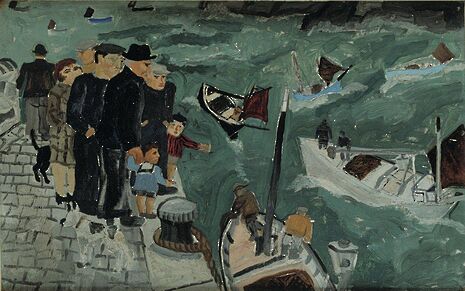Exhibition: Art and Life 1920-31
Robert Hawkins on paintings offering a view of the artist at Kettle’s Yard

It’s hard to imagine what the sea of Christopher Wood’s Herring Fisher's Goodbye would look like from another angle – from the shore, say, or from one of the boats. Ignore the sea for the moment and look at the sea wall. Based on its receding form, where should the horizon be? My guess is not too far above the hats of the huddling men. But the sea seems to gather in banks and slopes at the canvas’s edge; the water rises up to block out the sky. I remember playing with toy boats on a big blue sheet as a child: by billowing the edge of the cloth you could encourage scoops of air under your marine surface – but the boats stayed weighted to the carpet, no matter how turbulent the fabric around them. Wood plays a similar game with the fabric of space in his picture – the result is precarious, and a little claustrophobic. Excluding the sky makes the scene airless and uncomfortable; we’re drawn to the contrasts between the various chunks of sea that each boat negotiates. The black tug climbs a sheer wall of water; the white one sits, shoulders sunk low in the foam – and we see top-down into the waiting boat while it strains at its rope. The stone of the wall’s edge is almost a ship’s keel, from which the lines of the painting’s perspective rise and curl upwards. The world is seen through a herring-eye lens.
Art and Life 1920-1931 is really an exhibition about the way a painting can offer a window onto the world of the artist. In a good painting, as in Herring Fisher's Goodbye, you can feel something of the way the painter felt about life and the view they were painting. Wood was not a happy man by 1928 (he committed suicide in 1930) and I think you can feel a sense of enclosure and entrapment – but there are more gentle elements communicated too: from the minimal touches that make up the weighty rope we can tell its texture, its heaviness; the man’s hand gripping the boy’s arm feels secure and protective. The handling is loose but the effect is evocative.
The show is most successful when the comparisons it makes between artists are strong and direct. Where two artists’ versions of a similar view are hung side by side they throw into sharp relief these different experiences of being-in-the-world. This happens throughout the exhibition with surprising results. Winifred Nicholson all too often receives third or fourth billing in discussions of the St Ives School yet in every room, and every direct comparison, hers is the picture that stands out. We can tell what it felt like to look at the sun through rippled glass or veined flower petal, or how tissue folded and creased around a bowl. Ben Nicholson’s landscapes, by comparison, are lazy and insincere. He doesn’t seem happy until the show’s final room, where his serene geometric abstracts first arrive.
The exhibition’s organization is good but not faultless. Curated by the Nicholsons’ grandson, there is clearly a great knowledge of the paintings at work and the hanging is excellent. The decision to group paintings by location (Cumberland, London, Lugano) perhaps helps to compartmentalize them, but does little to change our understanding of each painting. It should also be said that the frequent visitor to Kettle’s Yard will know many of these pictures but this seems a small price to pay for a comprehensive survey of such an evocative body of work.
Art and Life 1920-31 runs until 11thMay at Kettle’s Yard, and is free.
 News / Caius mourns its tree-mendous loss23 December 2025
News / Caius mourns its tree-mendous loss23 December 2025 News / Cambridge welcomes UK rejoining the Erasmus scheme20 December 2025
News / Cambridge welcomes UK rejoining the Erasmus scheme20 December 2025 News / CUP announces funding scheme for under-represented academics19 December 2025
News / CUP announces funding scheme for under-represented academics19 December 2025 News / King appoints Peterhouse chaplain to Westminster Abbey22 December 2025
News / King appoints Peterhouse chaplain to Westminster Abbey22 December 2025 Interviews / Politics, your own way: Tilly Middlehurst on speaking out21 December 2025
Interviews / Politics, your own way: Tilly Middlehurst on speaking out21 December 2025







